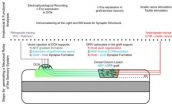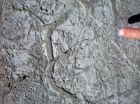(Press-News.org) WASHINGTON, Aug. 6, 2014—A new hand-held device that uses lasers and sound waves may change the way doctors treat and diagnose melanoma, according to a team of researchers from Washington University in St. Louis. The instrument, described in a paper published today in The Optical Society's (OSA) journal Optics Letters, is the first that can be used directly on a patient and accurately measure how deep a melanoma tumor extends into the skin, providing valuable information for treatment, diagnosis or prognosis.
Melanoma is the fifth most common cancer type in the United States, and incidence rates are rising faster than those of any other cancer. It's also the deadliest form of skin cancer, causing more than 75 percent of skin-cancer deaths.
The thicker the melanoma tumor, the more likely it will spread and the deadlier it becomes, says dermatologist Lynn Cornelius, one of the study's coauthors. Being able to measure the depth of the tumor in vivo enables doctors to determine prognoses more accurately—potentially at the time of initial evaluation—and plan treatments and surgeries accordingly.
The problem is that current methods can't directly measure a patient's tumor very well. Because skin scatters light, high-resolution optical techniques don't reach deep enough. "None are really sufficient to provide the two to four millimeter penetration that's at least required for melanoma diagnosis, prognosis or surgical planning," says engineer Lihong Wang, another coauthor on the Optics Letters paper.
Researchers have tried other methods, but they aren't much better. High-frequency ultrasound doesn't have enough image contrast, and magnetic resonance imaging and positron emission tomography have insufficient resolution and require expensive and bulky instruments.
"Any type of tissue diagnosis at this point in time requires taking tissue out of the person and processing it and looking at it under the microscope," Cornelius says.
But because taking a biopsy often only involves the removal of a part of a tumor—when it's in a cosmetically sensitive area, for instance—provisional measurements of the tumor depth are not always reliable. If, at the time of excision, the surgeon finds that the tumor goes deeper than initially thought, the patient may need yet another surgery.
Recently, researchers including Wang have applied an approach called photoacoustic microscopy, which can accurately measure melanoma tumors directly on a patient's skin—thus allowing doctors to avoid uncertainty in some circumstances.
The technique relies on the photoacoustic effect, in which light is converted into vibrations. In the case of the new device, a laser beam shines into the skin at the site of a tumor. Melanin, the skin pigment that's also in tumors, absorbs the light, whose energy is transferred into high-frequency acoustic waves. Unlike light, acoustic waves don't scatter as much when traveling through skin. Tumor cells will produce more melanin than the surrounding healthy skin cells, and as a result, the acoustic waves can be used to map the entire tumor with high resolution. The device has a detector that can then turn the acoustic signal into a three-dimensional image on a screen.
Wang, Cornelius and their colleagues previously built a similar desktop device, which shines the laser directly onto the tumor. But so much light is absorbed that very little penetrates to the tumor's lower layers. The latest version, however, is not only hand-held, but it also delivers light around and below the tumor, which generates a bright image of the tumor's bottom and an accurate measurement of its depth.
The researchers tested their device on both artificial tumors made of black gelatin and on real ones in live mice, showing that the instrument could accurately measure the depths of tumors—and do it in living tissue.
Initially, this tool will be mainly used for improving how doctors plan and prepare for surgeries, Cornelius says. But what's especially exciting, she adds, is that it can measure a tumor's entire volume—something that's never been possible with melanoma. If researchers can determine how the volume relates to cancer outcomes, then this tool could give doctors a new type of measurement for diagnosis and prognosis.
The researchers are now conducting further tests with human patients. The new device will have to prove effective in clinical trials before it is widely available. But other than that Wang says, the device is essentially ready for commercialization.
INFORMATION:
Paper: "Handheld photoacoustic microscopy to detect melanoma depth in vivo," Y. Zhou et al., Optics Letters, vol. 39, issue 16, pp. 4731-4734 (2014). (http://www.opticsinfobase.org/ol/fulltext.cfm?uri=ol-39-16-4731&id=298588)
EDITOR'S NOTE: Images are available to members of the media upon request. Contact Lyndsay Meyer, lmeyer@osa.org.
About Optics Letters
Published by The Optical Society (OSA), Optics Letters offers rapid dissemination of new results in all areas of optics with short, original, peer-reviewed communications. Optics Letters covers the latest research in optical science, including optical measurements, optical components and devices, atmospheric optics, biomedical optics, Fourier optics, integrated optics, optical processing, optoelectronics, lasers, nonlinear optics, optical storage and holography, optical coherence, polarization, quantum electronics, ultrafast optical phenomena, photonic crystals, and fiber optics. This journal, edited by Xi-Cheng Zhang of the University of Rochester and published twice each month, is where readers look for the latest discoveries in optics. Visit http://www.OpticsInfoBase.org/OL.
About OSA
Founded in 1916, The Optical Society (OSA) is the leading professional society for scientists, engineers, students and business leaders who fuel discoveries, shape real-world applications and accelerate achievements in the science of light. Through world-renowned publications, meetings and membership programs, OSA provides quality research, inspired interactions and dedicated resources for its extensive global network of professionals in optics and photonics. For more information, visit http://www.osa.org.
Contact:
Lyndsay Meyer
The Optical Society
202.416.1435
lmeyer@osa.org
New hand-held device uses lasers, sound waves for deeper melanoma imaging
2014-08-06
ELSE PRESS RELEASES FROM THIS DATE:
Trapped: Cell-invading piece of virus captured in lab by SLU scientists
2014-08-06
ST. LOUIS – In recent research published in the Journal of Biological Chemistry, Saint Louis University investigators report catching integrase, the part of retroviruses like HIV that is responsible for insertion of the viral DNA into human cell DNA, in the presence of a drug designed to thwart it.
This achievement sets the stage to use x-ray crystallography to develop complete images of HIV that include integrase, which in turn will help scientists develop new treatments for the illness.
Duane Grandgenett, Ph.D., professor at SLU's Institute of Molecular Virology ...
Transplanting neural progenitors to build a neuronal relay across the injured spinal cord
2014-08-06
Cellular transplantation for repair of spinal cord injury is a promising therapeutic strategy that includes the use of a variety of neural and non-neural cells isolated or derived from embryonic and adult tissue as well as embryonic stem cells and induced pluripotent stem cells. In particular, transplants of neural progenitor cells (NPCs) have been shown to limit secondary injury and scar formation and create a permissive environment in the injured spinal cord through the provision of neurotrophic molecules and growth supporting matrices that promote growth of injured host ...
Relay strategies combined with axon regeneration: A promising approach to restore spinal cord injury
2014-08-06
For decades, numerous investigations have only focused on axon regeneration to restore function after traumatic spinal cord injury (SCI), as interrupted neuronal pathways have to be reconnected for sensorimotor and autonomic recovery to occur. Experimental approaches have ranged from drug delivery and cell transplantation to genetic manipulations. Certainly, it would be an extraordinary achievement for injured axons to regenerate over long distances, to form synapses with target neurons, and to result in dramatic functional improvement. Dr. Shaoping Hou from Drexel University ...
Exposure to inflammatory bowel disease drugs could increase leukemia risk
2014-08-06
Bethesda, MD (August 6, 2014) – Immunosuppressive drugs called thiopurines have been found to increase the risk of myeloid disorders, such as acute myeloid leukemia and myelodysplastic syndrome, a rare bone marrow disorder, seven-fold among inflammatory bowel disease (IBD) patients. These data were reported in a new study published in Clinical Gastroenterology and Hepatology, the official clinical practice journal of the American Gastroenterological Association (AGA). Thiopurines are an established treatment for IBD patients, used to reduce inflammation and provide symptom ...
Burrowing animals may have been key to stabilizing Earth's oxygen
2014-08-06
Evolution of the first burrowing animals may have played a major role in stabilizing the Earth's oxygen reservoir, according to a new study in Nature Geoscience.
Around 540 million years ago, the first burrowing animals evolved. When these worms began to mix up the ocean floor's sediments (a process known as bioturbation), their activity came to significantly influence the ocean's phosphorus cycle and as a result, the amount of oxygen in Earth's atmosphere.
"Our research is an attempt to place the spread of animal life in the context of wider biogeochemical cycles, ...
Skull shape risk factors could help in the welfare of toy dog breeds
2014-08-06
New research has identified two significant risk factors associated with painful neurological diseases in the skull shape of the Cavalier King Charles Spaniel (CKCS). The findings could help in tackling these conditions in toy dog breeds and could be used in breeding guidelines.
The study conducted by undergraduate student, Thomas Mitchell, from the University of Bristol's School of Veterinary Sciences, and supervised by Dr Clare Rusbridge, is published online in the journal Canine Genetics and Epidemiology.
Syringomyelia (SM) is a painful condition in dogs and is ...
Aggressive behaviour increases adolescent drinking, depression doesn't
2014-08-06
Adolescents who behave aggressively are more likely to drink alcohol and in larger quantities than their peers, according to a recent study completed in Finland. Depression and anxiety, on the other hand, were not linked to increased alcohol use. The study investigated the association between psychosocial problems and alcohol use among 4074 Finnish 13- to 18-year-old adolescents. The results were published in Journal of Adolescence.
The results indicate that smoking and attention problems also increase the probability of alcohol use. Furthermore, among girls, early menarche ...
A synopsis of the carabid beetle tribe Lachnophorini reveals remarkable 24 new species
2014-08-06
An extensive study by Smithsonian scientists presents a synopsis of the carabid beetle tribe Lachnophorini. The research contains a new genus and the remarkable 24 new species added to the tribe. The study was published in the open access journal ZooKeys.
Beetles from the family Carabidae, commonly known as ground beetles are a large, cosmopolitan group, with more than 40,000 species worldwide, Carabid beetles range in size from 0.6 mm to 90.2 mm and occur in nature in several fractal universes influencing life therein as predators, ectoparasitoids, seed eaters, and even ...
Study: arctic mammals can metabolize some pesticides, limits human exposure
2014-08-06
Fortunately, you are not always what you eat – at least in Canada's Arctic.
New research from the University of Guelph reveals that arctic mammals such as caribou can metabolize some current-use pesticides (CUPs) ingested in vegetation.
This limits exposures in animals that consume the caribou – including humans.
"This is good news for the wildlife and people of the Arctic who survive by hunting caribou and other animals," said Adam Morris, a PhD student in the School of Environmental Sciences and lead author of the study published recently in Environmental Toxicology ...
New material structures bend like microscopic hair
2014-08-06
CAMBRIDGE, MA -- MIT engineers have fabricated a new elastic material coated with microscopic, hairlike structures that tilt in response to a magnetic field. Depending on the field's orientation, the microhairs can tilt to form a path through which fluid can flow; the material can even direct water upward, against gravity.
Each microhair, made of nickel, is about 70 microns high and 25 microns wide — about one-fourth the diameter of a human hair. The researchers fabricated an array of the microhairs onto an elastic, transparent layer of silicone.
In experiments, the ...





